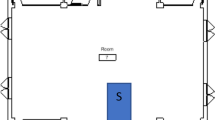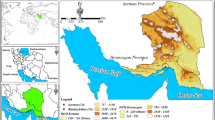Abstract
Green roof research has grown rapidly over the past decade. The green roof has been proposed as a lasting move to reduce urban-related complications. The installation of green roof systems has been made as a specific measure to achieve a wider objective to enhance environmental sustainability. As one of the effective parameters on energy consumption, buildings have always been considered the attention of engineers to reduce the amount of energy consumption. In this study, the effect of different factors including effect of different facades on energy consumption has been investigated, for this purpose, the Energy Plus software has been used to model and perform sample building calculations at three parts of Tehran, Tabriz and Bandar-e-Abbas. The results of this study show that the city of Tehran will have the best performance in reducing energy consumption and it will be suitable for Tabriz city of color concrete, as well as in Bandar-e-Abbas, a warm climate representative, the use of travertine 1 is suitable.











Similar content being viewed by others
Abbreviations
- \(\dot{Q}_{\text{i}}\) :
-
Heat transfer (W)
- \(h_{\text{i}}\) :
-
Convection heat transfer coefficient (W/m2.K)
- \(A_{\text{i}}\) :
-
Interior surface (m2)
- \(T_{\text{si}}\) :
-
Internal surface temperature (K)
- \(C_{\text{p}}\) :
-
Heat capacity (J/Kg.K)
- \(T_{\infty }\) :
-
Outdoor temperature (K)
- \({\dot{\text{m}}}\) :
-
Mass flow rate (kg/s)
- \(T_{\text{z}}\) :
-
Zone temperature (K)
References
Alcazar, S., & Bass, B. (2005). Energy performance of green roofs in a multi-story residential building in Madrid. In Greening Rooftops for Sustainable Communities, Washington, DC.
ASHRAE. (2017). Standard method of test for the evaluation of building energy analysis computer programs. New York: American Society of Heating, Refrigerating and Air-Conditioning Engineers, Inc.
Badescu, V., & Staicovici, M. D. (2006). Renewable energy for passive house heating: model of the active solar heating system. Energy Build, 38(2), 129–141.
Bashirpour-Bonab, H., & Javani, N. (2019). Investigation and optimization of solar volumetric absorption systems using nanoparticles. Solar Energy Mater Solar Cells, 194, 229–234.
Canty, J. L., & Frischling, D. (2019). Weatherbase. Find travel weather, climate averages, forecasts, current conditions and normals for 41,997 cities worldwide 2019; http://www.weatherbase.com/. Cited 2 Jan 2019.
Cascone, S., Coma, J., Gagliano, A., & Pérez, G. (2019). The evapotranspiration process in green roofs: a review. Build Environ, 147, 337–355.
Chen, X., Shuai, C., Chen, Z., & Zhang, Y. (2019). What are the root causes hindering the implementation of green roofs in urban China? Sci Total Environ, 654, 742–750.
Coma, J., Pérez, G., Solé, C., Castell, A., & Cabeza, L. F. (2016). Thermal assessment of extensive green roofs as passive tool for energy savings in buildings. Renew Energy, 5, 1106–1115.
De-Ville, S., Menon, M., Jia, X., Reed, G., & Stovin, V. (2017). The impact of green roof ageing on substrate characteristics and hydrological performance. J Hydrol, 547, 332–344.
Ebrahimpour, A., & Karimi, V. Y. (2012). The best methods to optimize energy consumption for an educational building in Tabriz. Modares Mech Eng, 12(4), 91–104.
Hashemi, S. S. G., Mahmud, H. B., & Ashraf, M. A. (2015). Performance of green roofs with respect to water quality and reduction of energy consumption in tropics: a review. Renew Sustain Energy Rev, 52, 669–679.
Herman, R. (2003). Green roofs in Germany: yesterday, today and tomorrow. In Greening Rooftops for Sustainable Communities (pp. 41–45). Chicago, 29–30 May 2003.
Huang, Y. Y., Chen, C. T., & Liu, W. T. (2018). Thermal performance of extensive green roofs in a subtropical metropolitan area. Energy Build, 159(15), 39–53.
Korol, E., & Shushunova, N. (2016). Benefits of a modular green roof technology. Procedia Eng, 161, 1820–1826.
Li, W. C., & Yeung, K. K. A. (2014). A comprehensive study of green roof performance from environmental perspective. Int J Sustain Built Environ, 3(1), 127–134.
Lindberg, R., Binamu, A., & Teikari, M. (2004). Five-year data of measured weather, energy consumption, and time-dependent temperature variations within different exterior wall structures. Energy Build, 36(6), 495–501.
Lobaccaro, G., Fiorito, F., Masera, G., & Poli, T. (2012). District geometry simulation: a study for the optimization of solar façades in urban canopy layers. Energy Procedia, 30, 1163–1172.
Lui, K., & Minor, J. (2005). Performance evaluation of an extensive green roof. Presentation at Greening Rooftops for Sustainable Communities, Washington DC.
Marefat, M., & Omidvar, A. (2006). Suitable exterior and outer shell design, effective way to prevent condensation occurrence in ceiling radiant cooling systems. Iran J Energy, 10(1), 3–18.
Prager, C., Köhl, M., Heck, M., & Herkel, S. (2006). The influence of the IR reflection of painted facades on the energy balance of a building. Energy Build, 38(12), 1369–1379.
Sangkakool, T., Techato, K., Zaman, R., & Brudermann, T. (2018). Prospects of green roofs in urban Thailand—a multi-criteria decision analysis. J Clean Prod, 196, 400–410.
Susorova, I., Angulo, M., Bahrami, P., & Stephens, B. (2013). A model of vegetated exterior facades for evaluation of wall thermal performance. Build Environ, 67, 1–13.
The UK’s Leading Independent Green Roof (2010). https://livingroofs.org/. Accessed 13 Jan 2019.
UK NCM (2018). The National Calculation Method for the EPBD (Energy Performance of Buildings Directive). http://www.uk-ncm.org.uk/index.jsp. Accessed 18 Dec 2018.
Vijayaraghavan, K. (2016). Green roofs: a critical review on the role of components, benefits, limitations and trends. Renew Sustain Energy Rev, 57, 740–752.
Wong, N. H., Chen, Y., Ong, C. L., & Sia, A. (2003). Investigation of thermal benefits of rooftop garden in the tropical. Build Environ, 38(2), 261–270.
Zhang, Z., Szota, C., Fletcher, T. D., Williams, N. S. G., & Farrell, C. (2019). Green roof storage capacity can be more important than evapotranspiration for retention performance. J Environ Manag, 232, 404–412.
Zolfaghari, S. A., & Jajaram, E. N. (2015). Evaluation of the influence of exterior façade on the annual energy consumption of building in different climates of Iran. Iran J Energy, 17(4), 69–80.
Acknowledgements
The authors wish to thank all who assisted in conducting this work.
Author information
Authors and Affiliations
Corresponding author
Rights and permissions
About this article
Cite this article
Bashirpour-Bonab, H. Simulation and optimization of energy consumption systems in buildings in varying climatic conditions. Int J Energ Water Res 3, 203–211 (2019). https://doi.org/10.1007/s42108-019-00028-6
Received:
Accepted:
Published:
Issue Date:
DOI: https://doi.org/10.1007/s42108-019-00028-6




